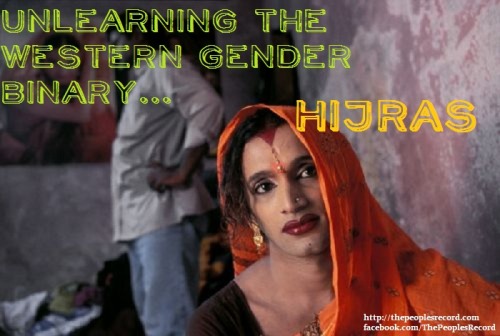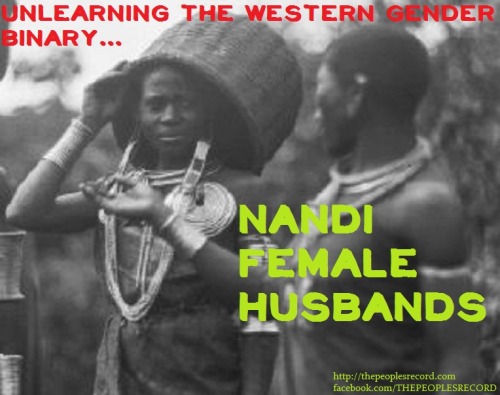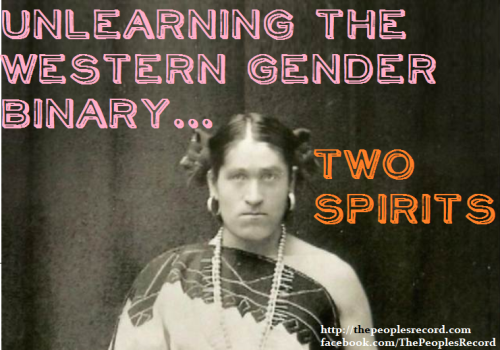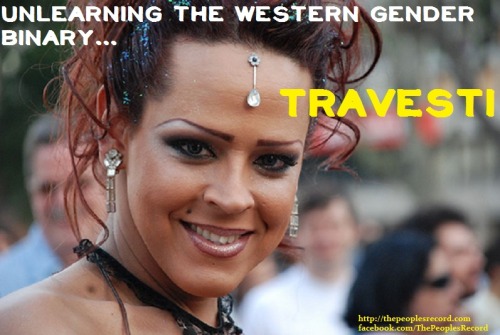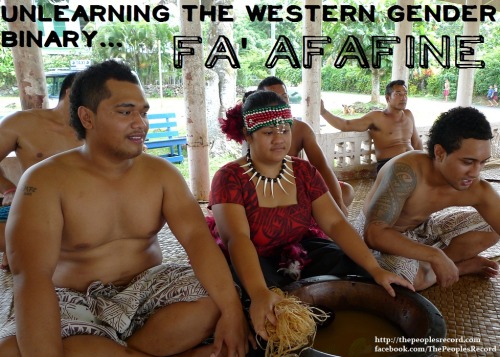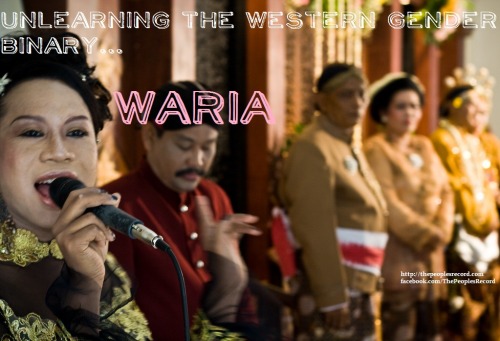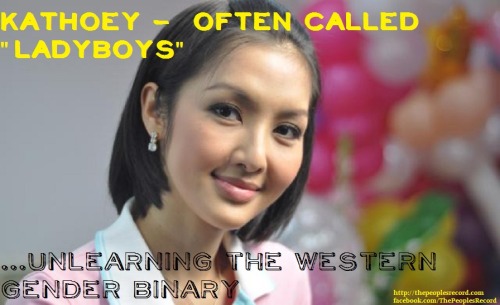mocosyamores:qbits:thepeoplesrecord:Going beyond the Western gender binary - unlearning our backward
mocosyamores:qbits:thepeoplesrecord:Going beyond the Western gender binary - unlearning our backward cultural conditioning In Western colonial society (which dominates many aspects of the globalized, capitalist world today) we operate under the presumption that there are only two genders, male and female. But gender is a social construction. One’s options for what gender they identify with are shaped by the culture they are born into. Biological factors are most-often the primary driving forces that choose among the available socially-constructed gender categories. Cultures around the world have different ways of talking about, thinking about, and identifying gender. It’s often a challenge for (particularly cis-sexual) Westerns to think about other ways gender can be socially constructed. Westerns have the false equivalency of gender and sex drilled into their eternal psyche from the time they are very young, and re-enforced through examples in popular culture. There is no biological reality to gender. Many Westerners have the bizarre belief that one’s XY-sex-determination should also inform one’s gender identity, a socially constructed role in society. In some cultures, there is no distinction made between gender and sexual orientation and the same can be said for sexual orientation - our culture socially-constructs the options and our biology helps us identify which socially-constructed option feels most ‘right’ and best resonates with us. I’ve attached some photos to offer some examples of non-colonial, non-Western construction of gender. They’ve all been uploaded onto our Facebook page photostream in case you’d like to ‘like’ or ‘share’ them there. There are literally hundreds of ‘third-gender’ identifying peoples around the world. The eight I’ve chosen are mostly examples I remember from some of my anthropology courses but if you google ‘third genders’ you can find many lists and examples. Who cares? Why it matters.The most obvious reason to care about the way our culture has constructed gender and sexual orientation is to deepen one’s capacity for solidarity with people who identify as transgender, transsexual, and others whose gender or sexual identity exists outside of binary Western culture. But there are other reasons as well. Western culture’s binary nature often creates non-sensical, problematic binary identity constructions that are inherently problematic. For example, I believe that Western masculinity (dominance, aggression, lack of communication, lack of emotional expression, etc) is inherently problematic. I believe that to be the reason why most acts of large-scale-violence and terror are committed by men (see: 100% of the mass school shootings in the United States), and I believe it fosters a degree of internal misery within people who heavily adopt these particular ‘masculine’ traits. In the age of information, and the age of global connectivity, there is no longer any reason (particularly for young people) to feel isolated or restricted to Western definitions of gender, sexual orientation and identity in general. I think the social ramifications of a generation where more and more people begin to identify outside of the gender binary would be tremendous, and I think we should all consider how we can unlearn our cultural conditioning to embrace other, perhaps less exploitative and dominating identities. Background information on the identities depicted in the above images: HijrasHijras are male-body-born, feminine-gender-identifying people who live in South Asia (mostly in India & Nepal). Many Hijras live in well-defined, organized, all-Hijra communities, led by a guru.Although many Hijras identify as Muslim, many practice a form of syncretism that draws on multiple religions; seeing themselves to be neither men nor women, Hijras practice rituals for both men and women.Hijras belong to a special caste. They are usually devotees of the mother goddess Bahuchara Mata, Lord Shiva, or both.Nandi female husbandsAmong the Nandi in Western Kenya, one social identity option for women is to become a female husband, and thus a man in society’s eyes. Female husbands are expected to become men and take on all of the social and cultural responsibilities of a man, including finding a wife to marry and passing on property to the next generation through marriage. Female husbands may have lived their lives as women and may even be married to a man, but once she becomes a female-husband, she is expected to be a man. Women married to female-husbands may have sex with single men uninterested in commitment in order to become pregnant, but the female-husband (who is often an older woman, often a widow) will father the child of said pregnancy and treat the child like her own.Two-spirited peopleTwo-Spirit is an umbrella term sometimes used for what was once commonly known as ‘berdaches’, Indigenous North Americans who fulfill one of many mixed gender roles found traditionally among many Native Americans and Canadian First Nations communities. The term usually indicates a person whose body simultaneously manifests both a masculine and a feminine spirit. Male and female two-spirits have been “documented in over 130 tribes, in every region of North America.”TravestiIn South America (with a large presence in Brazil), a travesti is a person who was assigned male at birth who has a feminine gender identity and is primarily sexually attracted to masculine men. Therefore, sometimes the distinction between gender identity and sexual orientation is not made. Travestis have been described as a third gender, but not all see themselves this way.Travestis often will begin taking female hormones and injecting silicone to enlargen their backsides as boys and continue the process into womanhood.The work of cultural Anthropologist Don Kulick (a gay male by Western definitions) in Brazil demonstrated that gender construction in Brazil is binary (like Western gender construction), but unlike Western gender construction, instead of having a male-female binary, there is a male-notmale. In this particular construction of gender:Males include: men who have sex with women, men who have sex with Travestis but are never on the receiving end of anal sex, men who have sex with men but are never on the receiving end of anal sex.Not-males include: women, men who receive anal sex from ‘male’ gay men or from Travestis.Fa’afafineFa’afafine are the gender liminal, or third-gendered people of Samoa. A recognized and integral part of traditional Samoan culture, fa’afafine, born biologically male, embody both male and female gender traits. Their gendered behavior typically ranges from extravagantly feminine to mundanely masculineWariaWaria is a traditional third general role found in modern Indonesia. Additionally, the Bugis culture of Sulawesi (one of the four larger Sunda Islands of Indonesia) has been described as having three sexes (male, female and intersex) as well as five genders with distinct social roles.Six Genders of old IsraelIn the old Kingdom of Israel (1020–931 BCE) there were six officially recognized genders:Zachar: maleNekeveh: femaleAndrogynos: both male and femaleTumtum: gender neutral/without definite genderAylonit: female-to-male transgender peopleSaris: male-to-female transgender people (often inaccurately translated as “eunuch”)Kathoey (often called ‘ladyboys’)Australian scholar of sexual politics in Thailand Peter Jackson’s work indicates that the term “kathoey” was used in pre-modern times to refer to intersexual people, and that the usage changed in the middle of the twentieth century to cover cross-dressing males, to create what is now a gender identity unique to Thailand. Thailand also has three identities related to female-bodied people: Tom, Dee, and heterosexual woman.-RobertExcellent overview of non-binary gender categories. Sadly, Western imperialism has all but extirpated many traditional concepts of non-dualistic sex and gender categories through residential schools and religious indoctrination. -QThis gives me all kinds of gender life and power. -- source link
Tumblr Blog : thepeoplesrecord.tumblr.com
